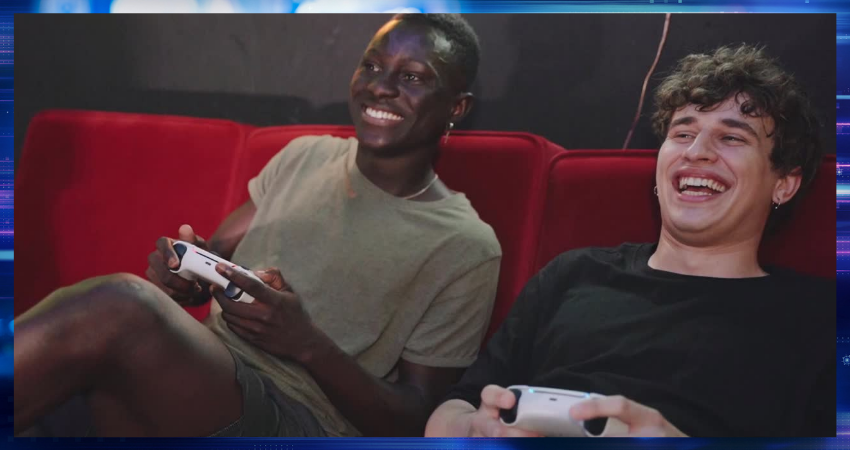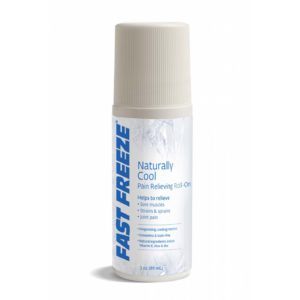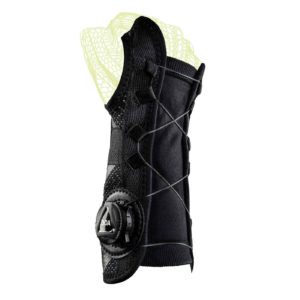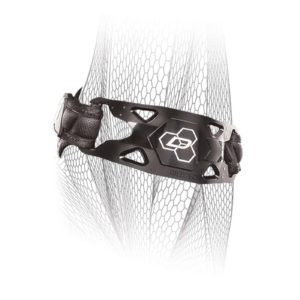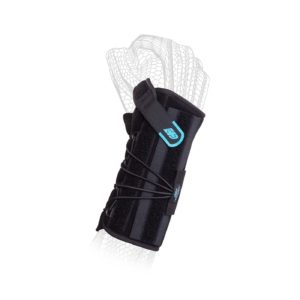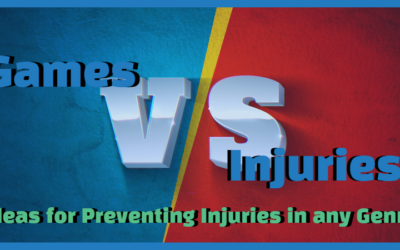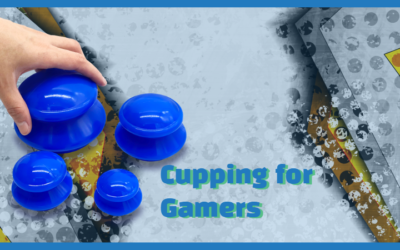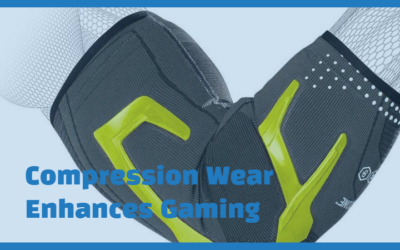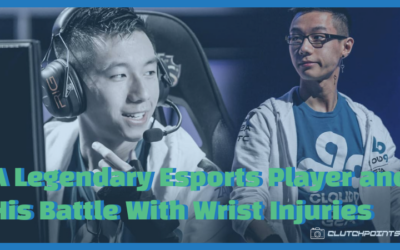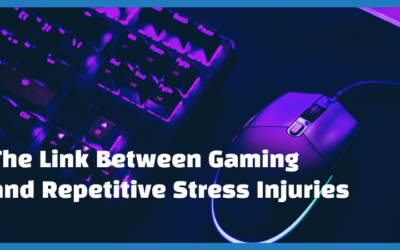Esports professionals and gaming enthusiasts often spend hours navigating complex games with increasingly challenging levels. This gradually takes a toll on the body, leading to a number of common gaming injuries. Console gamers frequently experience hand injuries, while PC gamers usually develop wrist problems. All avid gamers typically experience some form of back pain.
Common Types of Injuries
Gamer Hand Pain
Gamer’s thumb (De Quervain’s Tenosynovitis) is an overuse injury that develops when tendons in the thumb and wrist become inflamed. It’s caused by repetitive thumb strain [1]. The symptoms include: pain in the hand, thumb, and wrist that worsens with movement; a popping sensation when the thumb is moved; and swelling in the lower region of the thumb.
Ulnar nerve irritation (Cubital tunnel syndrome) is a syndrome that develops due to pressure, stretching, or inflammation of the ulnar nerve where it passes through the cubital tunnel in the elbow [2]. The pain reflects hitting the funny bone. It’s caused by holding the arms and hands in the same position (prolonged elbow flexion) while tightly gripping a controller for extended periods. Pressing the elbows against an armrest or the knees increases the risk of ulnar nerve irritation. The symptoms include: aching pain in the elbow; numbness or tingling in the ring finger and pinky; and hand weakness (loss of grip).
Gamer Wrist Pain
Carpal tunnel syndrome (Median nerve compression) is a syndrome that develops when the median nerve that runs through the carpal tunnel becomes compressed [3]. It’s caused by repeatedly gripping a controller or mouse while gaming. This activity leads to overuse of the tendons and is most prevalent in gamers who play computer video games.
The symptoms of carpal tunnel syndrome include: pain, numbness, burning, tingling, and weakness in the wrist and hand; pins and needles in the hand; and pain that extends toward the elbow.
Keyboard wrist pain – pain, irritation, or inflammation of the tendons in the wrist due to repetitive movements. It’s caused by performing the same hand movements repeatedly during long hours of continuous gaming. This type of pain is more common in PC gamers. The symptoms include: aching pain in the wrist that worsens during or after activity, swelling of the wrist, and joint stiffness [1, 2].
Gamer Back Pain
Sciatica is a painful condition that results from the irritation or compression of the sciatic nerve in the gluteal (buttocks) region. It’s caused by inflammation of the piriformis muscle, which is a hip muscle that runs along the same region as the sciatic nerve [4]. The symptoms include: sharp, shooting pain or burning in the lower back, buttocks, thigh, lower leg, or foot; numbness, tingling, or pins and needles in the back or legs.
Other Common Gaming Injuries
Mouse elbow (lateral epicondylitis or tendinopathy) is the development of pain in the extensor tendons of the forearm. These tendons surround the lateral epicondyle, which is a bony structure on the side of the elbow. The extensor muscles that enable the wrists to bend and the hand to open may be also affected. However, lateral epicondylitis is described as a tendinopathy (painful condition of the tendons) because it doesn’t usually cause substantial inflammation [6, 7].
Mouse elbow is caused by constantly pressing or holding the keys on the mouse while moving the arm as this repetitive motion of shifting, squeezing, and gripping the mouse can make extensor tendons and muscles in the forearm fatigued and weak. The symptoms include: elbow pain, wrist pain while using a mouse, pain while bending or flexing the fingers, and mild inflammation immediately following the injury.
Neck strain – a type of pain associated with looking at a screen (e.g., a monitor) for long periods of time. It’s caused by subconsciously leaning forward while gaming [1, 2]. This incorrect posture increases the weight of the head, which places excessive pressure on the neck. Bending the head forward can increase the weight of the head by about five times its regular weight. This may also damage nerves, muscles, and ligaments in the neck.
Eye strain – fatigue or eye pain that develops when the eye muscles (intraocular and extraocular muscles) are overworked. It’s caused by a limited area of gaze and short, static focal distance that accompanies long hours of staring at a screen while gaming [5]. The symptoms include: eye pain, fatigue, blurred vision, headaches, double vision, dry eyes, burning or stinging, sensitivity to light, eye redness, and strained nighttime vision.
Blood clots (Gamer’s thrombosis) – deep vein thrombosis, which refers to the formation of blood clots in the legs from sitting for long hours while gaming [8]. Sitting for too long reduces proper blood circulation as this causes coagulation of blood in the veins that leads to clots that can break apart and travel to different parts of the body (e.g., lung, heart) where they can become lodged. This may result in a life-threatening situation if the clot significantly restricts blood flow. The symptoms include: pain and swelling in the leg, warm skin, lower leg cramping, or skin discoloration.
Poor posture, core weakness, and poor balance – incorrect body positioning that accompanies extended hours of gaming [5, 8-10]. Many gamers bend forward or slouch while sitting for long periods of time. Gaming devices such as the mouse, controller, and monitor also cause gamers to hold certain body parts (e.g., wrists, hands, elbows, and head) in fixed positions for hours at a time. The symptoms of poor posture include: body pain, reduced blood circulation, joint stiffness and weakness, and muscle, ligament, tendon, or bone damage.
Mouse shoulder – a condition that develops in the proximal tendon of the biceps brachii muscle. This muscle promotes shoulder and elbow flexion. It is caused by misuse or overuse of the shoulder that leads to an imbalance of the fiber orientation in the proximal tendon. Accordingly, the injury is referred to as tendinopathy, which reflects pain due to dysfunction rather than inflammation [9]. This injury is common in PC gamers. The symptoms include: pain in front of the shoulder or the upper arm; an increase in pain when the shoulder is raised upward and forward; discomfort when the arm is moved backwards; and shoulder weakness.
Repetitive motion pain – reflects a group of muscular conditions that develop due to repeated motions that accompany gaming. The pain is caused by uninterrupted repetitive actions, muscle fatigue, incorrect posture, and awkward or unnatural movements (e.g., overextension, twisting the wrist or arm). This form of pain includes discomfort caused by tendonitis, trigger finger, carpal tunnel syndrome, etc. The symptoms include: pain, numbness, tingling, redness or swelling of the affected area, which are most commonly the wrists, hands, elbows, neck, back, and shoulders [9, 10].
Prevention Is the Best Cure
Take a Break
Taking frequent breaks is one of the most important ways to prevent common gaming injuries. Stretching exercises during breaks is another useful strategy. For those who experience recurring injuries, a physical therapist may recommend wearing a wrist splint and hand brace for stabilization. These devices decrease the amount of pressure placed on the hand, wrist, arm, and elbow during movement [1-4].
Ice Packs
Minor repetitive stress injuries can be treated by icing an injured hand, wrist, or thumb to target swelling, inflammation, and pain [4, 6]. It’s easy to use an ice pack during a break or after a long gaming session.
Over-the-Counter Painkillers
Minor repetitive stress injuries can also be treated with non-steroidal anti-inflammatory drugs (NSAIDs) such as aspirin or ibuprofen [4, 6].
Therapeutic Massage
Therapeutic massage is beneficial for targeting or preventing gaming injuries. This form of treatment boosts the circulation of nutrients and oxygen that promote the rejuvenation of inflamed or damaged tissue. It also helps flush away toxins that are linked to gaming-induced inflammation. Receiving therapeutic massages regularly lessens tension in muscles, tendons, and ligaments. In addition, this approach helps break down scar tissue, allows muscles to regain strength, and lowers the risk of recurring injuries.
Working closely with a physical therapist can ensure that the appropriate massage techniques are performed. Incorporating positional changes that support proper hand and body positioning also helps reduce the incidence of back pain as well as repetitive strain injuries.
Good Posture
Finding ways to avoid poor posture while gaming is also beneficial. Slouching can be corrected by firmly pressing the back against a chair until sitting upright becomes a habit [1-3].
Overall, trying to keep the hands and body in a neutral position while gaming, taking frequent breaks, and practicing stretching exercises can help lower the risk of common gaming injuries.
References
- Helliwell PS, Taylor WJ. Repetitive strain injury. Postgrad Med J. 2004;80(946):438-43.
- van Tulder M, Malmivaara A, Koes B. Repetitive strain injury. Lancet. 2007; 369(9575):1815-22.
- Bhanderi DJ, et al. Computer Use and Carpal Tunnel Syndrome: A Case-control Study. Indian J Occup Environ Med. 2017;21(3):109-114.
- Jankovic D, Peng P, van Zundert A. Brief review: Piriformis syndrome: Etiology, diagnosis, and management. Can J Anesth. 2013; 60:1003-12.
- Randolph SA. Computer vision syndrome. Workplace Health Saf. 2017 Jul;65(7):328.
- Kahlenberg CA, et al. New Developments in the Use of Biologics and Other Modalities in the Management of Lateral Epicondylitis. Biomed Res Int. 2015; 2015: 439309.
- Andres BM, et al. Treatment of Tendinopathy: What Works, What Does Not, and What is on the Horizon. Clin Orthop Relat Res. 2008;466(7):1539-1554.
- Rambaran KA, Alzghari SK. Gamer’s Thrombosis: A Review of Published Reports. Ochsner Journal. 2020;20(2):182-186.
- Ratzlaff CR, Gillies JH, Koehoorn MW. Work-related repetitive strain injury and leisure-time physical activity. Arthritis Rheum. 2007;57(3):495-500.
- Tjepkema M. Repetitive strain injury. Health Rep. 2003;14(4):11-30.

